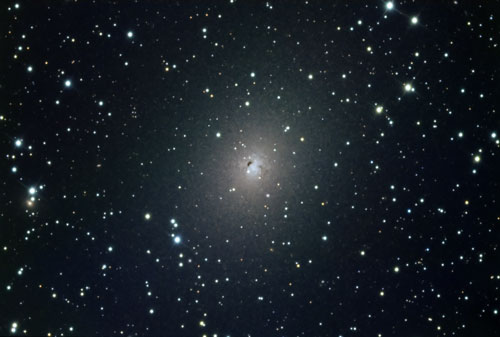|
| |
NGC185
Image Information
Quoted from SEDS:
This galaxy was discovered (as a "Faint Nebula") by William Herschel on
November 30, 1787, and cataloged by him as H II.707. His son John
Herschel observed it again and cataloged it as h 35 in his catalog of
1833, and as GC 90 in his General Catalogue of 1864. They
described it as follows:
- Pretty bright, very large, irregularly round, very gradually
much brighter to the middle, resolvable, 5 or 6 [arc min] diameter
(1789)
- Pretty bright; large; round; gradually brighter to the middle;
full 60" diameter (1833)
- Pretty bright; very large; irregularly round; very gradually
much brighter to the middle; barely resolvable [mottled] (1864)
A first photograph of NGC 185 was obtained by James Edward Keeler with
the Crossley Reflector of Lick Observatory between 1898 and 1900.
NGC 185 was recognized as a Local Group member galaxy, together with
its neighbor
NGC 147, by Walter Baade (1944), when he
resolved them into stars with the 100-inch reflector on Mt. Wilson.
These two dwarf elliptical galaxies apparently form a physical pair, as
they are only 58 arc minutes separated; according to
Van den Bergh, they are probably
gravitationally bound in a physical pair. Both are more remote satellite
galaxies of the
Andromeda
Galaxy M31, but are at a somewhat closer distance to us these times.
Modern distance estimates for NGC 185, adjusted for the scale we use
here, correspond to some 2.3 million light-years. |

800
1600
Full
| This image is compiled from 11 - 15 minute
R, G, & B images and 37 - 15 minute luminance. A total of 17.5
hours of data was used for this image. All data was acquired using
MaxImDl/CCD version 5 using ACP. Images were reduced,
De-Bloomed, average combined and saved in MaxImDl version 5.
Alignment was done using Registar. The master images were combined,
registered and the color image created. Photoshop CS 4 was used for
cleanup of blooms, curves, and levels. The image data was
collected over Oct. 19 - Nov. 14, 2009
|
Equipment and Location Information
| Date |
Oct. 19 - Nov. 14, 2009
|
| Location |
Dogwood Ridge Observatory |
| Optics |
OGS 12.5" RC |
| Mount |
Astro Physics AP1200GTO |
| Camera |
SBIG ST10XME |
| Filters |
Baader LRGB
1.25" mounted |
| Conditions |
Temperature middle 20s - low
30s with very
moderate seeing. Transparency good to moderate. |
|
